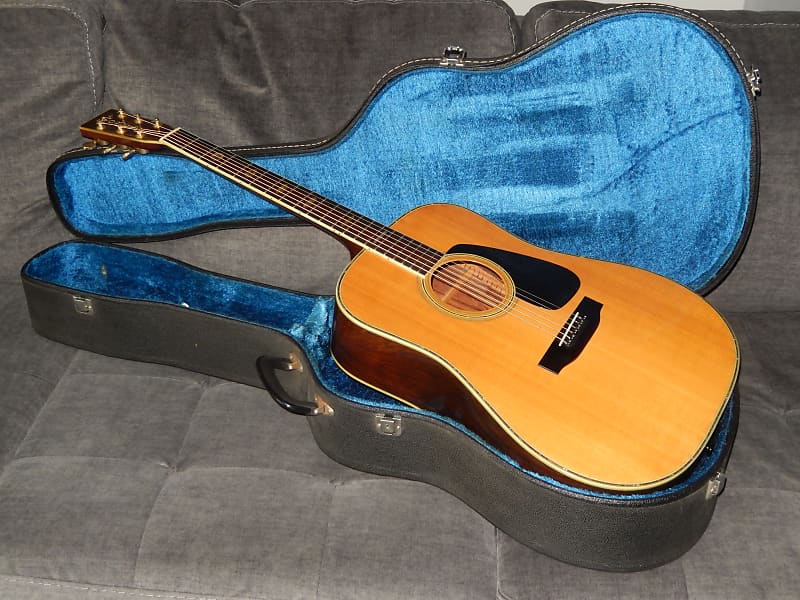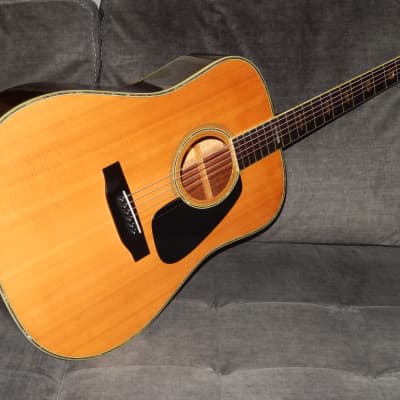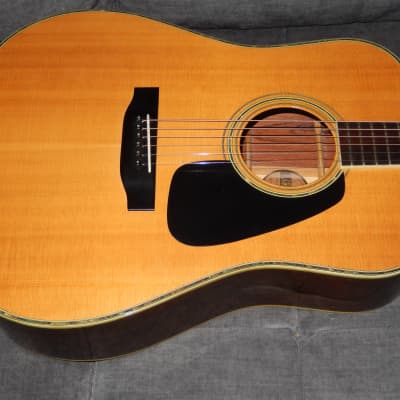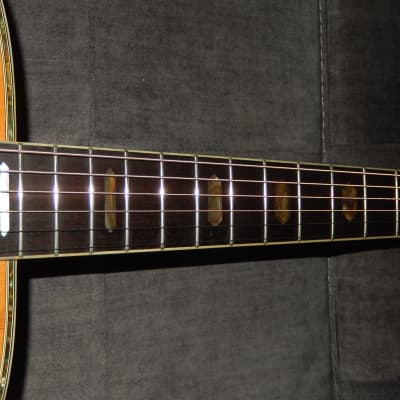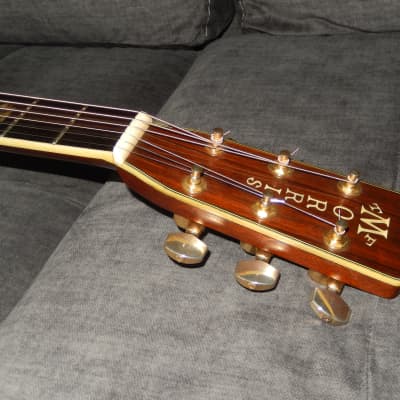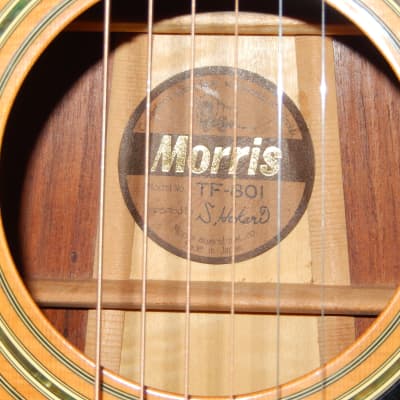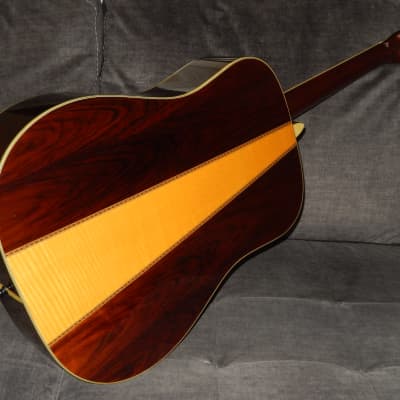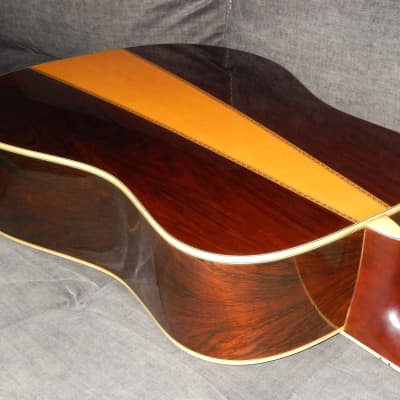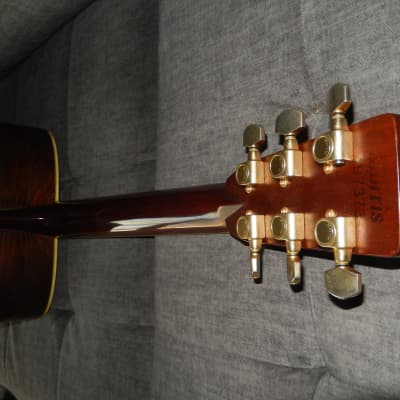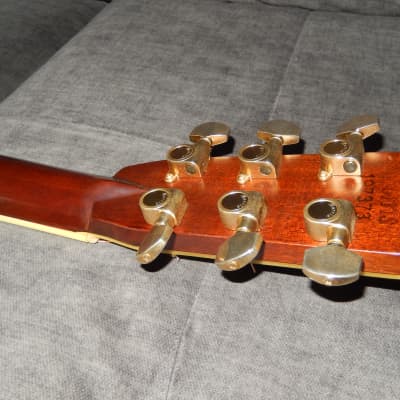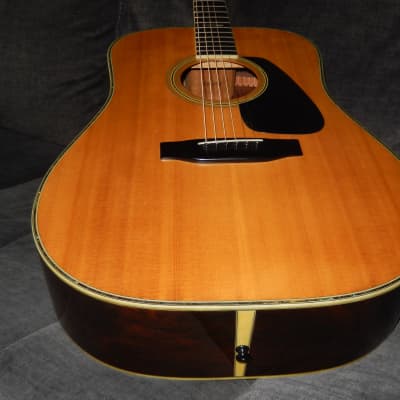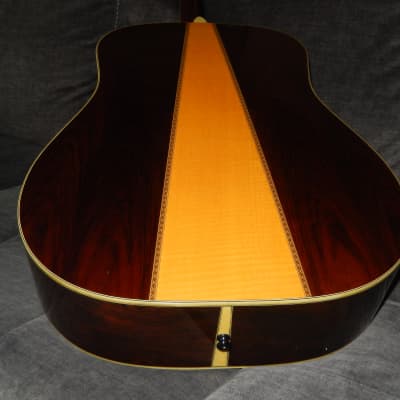Several hundred guitars I have sold in the past are presented at Facebook.com/Victors.Guitar.Library.
Morris TF801 acoustic guitar
Most acoustic guitar players around the world know that since late 1960s Japanese makers were creating wonderful “copies” of Martin, Gibson and Guild guitars. Many experienced players know that many of these “copies” sound better than the “originals”.
This guitar was handmade early 1980s by best Morris luthiers at their Matsumoto workshop. It was a part of Morris TF series that was launched in late 1970s. Until 1980 TF series guitars were still labelled as Wxx. Starting in 1981 all models were labelled as TFxxx. Model TF801 was the same guitar as W50 made in earlier years.
The construction and looks of this wonderful guitar are based on Martin D41 blueprint. I won’t however call it a “copy” of Martin D41. The word “copy” suggests a product of somewhat lower quality than the “original”, while this guitar can easily beat many brand-new Martin guitars.
As of today, if you wanted to order a brand new guitar made in Japan with similar woods, looks and construction it would cost you at least $2500. If in addition you would like it to have the same vintage sound the price would be at least $3500. It is not that difficult to find out what are the current prices of Japanese made acoustic guitars.
It offers impressive volume and superb response. Its sound is ultra-rich. Basses are deep but very “clean”. Trebles are metallic but very sweet at the same time. All notes have their unique colors, all are super clear and super well separated. When chords/arpeggios are played guitar releases a bounty of overtones and harmonies. With its current action it plays ultra-easy.
You don't have to believe me, but you will believe your own senses. Sooner or later you'll agree that it is very difficult to find better sounding Martin guitar priced below $5000.
Overall condition of this guitar can be described as very good. Besides the tuning keys that have lost their original luster, there are several light indentations within the finish of the soundboard. They are very hard to photograph and therefore you can’t see them on the pictures. Very importantly guitar doesn’t have any structural problems, its neck is straight and fingerboard and (leveled) frets remain in very good condition.
Specification:
Top: Thin plate of very tight grain Solid Spruce with reinforcing ring of wood glued underneath the sound-hole /Martin style X bracing with not scalloped braces /ultra-light gloss finish
Back: Brazilian Rosewood/Chestnut/Brazilian Rosewood “laminates” /lacquer
Sides: Brazilian Rosewood “laminates” /lacquer
“Laminated” is quite unfortunate term regarding Japanese made guitars. These plates were made from 2 layers of solid wood glued together with natural resins. They were made so well that they performed as good as solid woods while being far less expensive in guitar production and far more resistant to cracking in regular use. In recent years many guitar makers around the world adopted a new term "semi-solid" to describe these plates.
Neck: Mahogany with 2-way truss rod
Fingerboard: Brazilian Rosewood
Nut width: 43mm
Scale: 655 mm
The action is set to 2.50 mm under E6 and 2.00 mm under E1, with practically no extra room on the saddle.
My posted for sale guitars are stored in climate-controlled vault already packed into shipping boxes, with loosen strings. Because the strings are loosened, they don’t pull the neck or soundboard, and the neck may relax (straighten more) and the soundboard flatten a bit, which may result with the string action being lower than my it was with my original settings and lead to buzzes and/or dead notes after guitar arrives to you. Such a change in neck curvature can also happen just because of vibrations during the shipment and/or temperature fluctuations. Therefore, you must be ready to make final action adjustment yourself and or have it done by professional. All that really needs to be done is the simple neck adjustment by using the truss rod (turning the truss rod counterclockwise will relief the neck and strings will move away from the frets).
THAT IS WHY TRUSS RODS ARE INSTALLED IN THE NECKS OF ACOUSTIC GUITARS!!!
This guitar will be shipped in used hard shell case in still good condition.
If you visit facebook.com/Victors.Guitar.Library you will see several hundred guitars I have sold in the past.
Some info related to this guitar
Moridaira (Morris Guitars)
Founded in 1967 by Toshio "Mori" Moridaira, the Moridaira factory produced high-quality guitars, including the infamous Morris badged guitar. Moridaira also produced badged guitars for Hohner including Coronado, Futurama, H.S. Anderson, Lotus (some) and Sakai.
The Morris Guitars company has been building quality handcrafted instruments in Nagano, Japan for a long time. Mr. Toshio Moridaira, the founder, was the first distributor in Japan to carry both Fender and Gibson lines. In 1964, due to his working relationship with Gibson, Mr. Moridaira was able to visit the Gibson factory in Kalamazoo, Michigan. An employee at Gibson nicknamed him “Mori” at that time.
In 1967, he founded the Morris Guitars company. He named it Morris, taken from the nickname given to him a while back. Morris produced copies of dreadnought and small jumbo models based on Martin and Gibson designs. Since then, Morris Guitars have enjoyed an outstanding reputation in Japan and other countries for making high quality guitars.
In 1974, Morris introduced their guitars at the NAMM show. In 1978, Morris introduced the Tornado line, thin body acoustic-electric guitars inspired by the Ovation design. Up until the early 80s, the U.S. market saw a variety of guitars that Morris imported from Japan.
In 2001, after a lengthy absence, Morris Guitars re-entered the U.S. market. They participate in the annual Winter NAMM Show in Anaheim, CA. Morris Guitars currently offer a wonderful line of fingerstyle guitars with a middle price range. Custom hand built models are also available. Today, Morris Guitars are played by some of the world’s finest fingerstyle guitarists. Our products are available through a small number of dealers here in the U.S.
